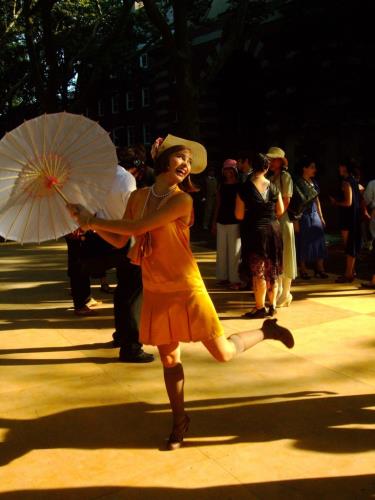Winner of the Taipei Literature Award, China Times Literary Award, Lin Rong-san Literature Award and Liang Shih-chiu Literature Award. Ruby likes poetry and essays, photography and drawing; Loves discovering the old and the new, warm humour, and finding truth in the absurd; hopes to play a role in Lou Ye’s films, and writes lyrics for singers she loves.

Since 2011, the Dreamland Orchestra has led a two-day jazz party each summer on Governors Island in New York, as if Gatsby could be there. Photo courtesy of Ruby Chen
New York’s vibrant nightlife always faithfully reflects the pulse of the contemporary art scene.
It has been this way since Fitzgerald’s jazz era to the age of punk rock and disco—the best, generation-defining literature, art and music can be found anywhere in the city, whether it’s upper crust literati or rebellious youth parties.
As the spiritual home of underground rock in New York, CBGB, reaches its end, New Yorkers are struck by a deep sense of crisis: with these icons a thing of a past, can 21st century New York still throw up any surprises?
Seasoned New Yorkers who love a thrill are not happy with the gentrification of the city. Times Square feels like a virtual Disneyland. Everything in New York just feels too “safe”, too warm, too middle-class. Even though New York’s arts scene remains exceptionally competitive, I understand their concerns. New York has always been fearless, creating some of the most thrilling and progressive artists in history. But the Beat Generation and the youth of the Chelsea Hotel are both things of the past. Everyone is waiting for the next big cultural epoch.
Yet in the digital age, young people are interacting with each other in drastically different ways. It’s a post-modern age where anyone can be famous. At the end of the 20th century, independent sub-culture groups like Rubulad started to emerge in New York’s fringes. Later, Dances of Vice was established in 2007, giving rise to more such underground party groups. These “alternative mainstream” groups didn’t want to be constrained anymore by venues, schedules and themes. For them, every appearance could be a theme night, every participant could be a star. Times and venues were unpredictable and announced online. These are truly “moveable feasts”.
In the past, parties in New York were always closely linked to clubs and celebrities. New Yorkers probably won’t forget the outrageousness of Club Kids, or how young rockers got their start at CBGB. Andy Warhol, Madonna and Keith Haring rubbed shoulders and sparked fireworks at iconic places like Club 57, Mudd Club, Studio 54 and Tunnel.
These are all long-gone. 21st century New York is all about finding everyone’s own fifteen minutes of fame. The dissemination of culture is no longer topdown and driven by celebrities and brands. It has become much more accessible and egalitarian. For example, Dances of Vice is a successful, organically grown group. Its supporters come from the internet, music, performing arts, special effects, theatre and other industries. The audience is typically a diverse and interesting group of people. Each show can feel like a movie set in a different time and space, the visual and audio effects literally breathtaking. In just a few years, Dances of Vice has even spawned modelling, party planning, cosmetics and clothing side businesses, further helping to financially support the group.
Perhaps this is the new world we now live in thanks to the digital age. In this world, no one is an island and no one needs to take the leader. If there’s a will, anywhere can be a stage, at any moment.